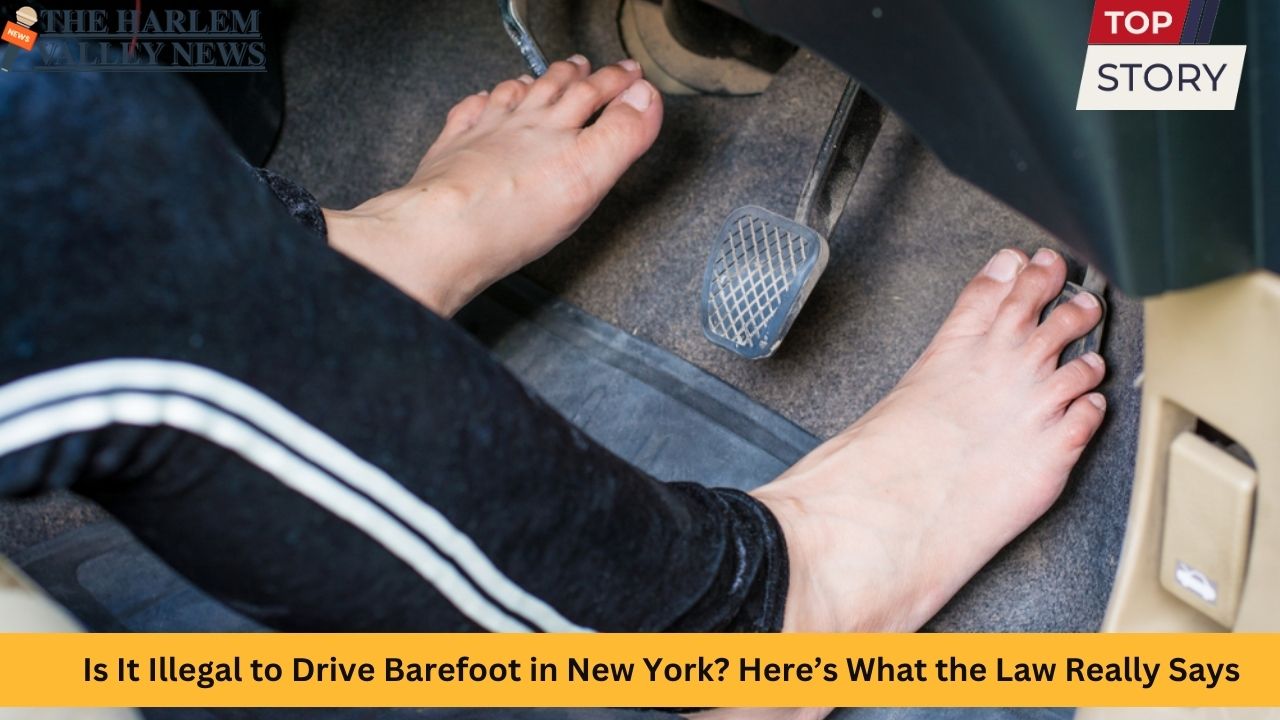Have you ever slipped off your shoes after a long walk through Central Park, jumped in your car in Albany after a business meeting, or left the beach in Montauk with sandy feet and wondered: Is it illegal to drive barefoot in New York? Despite persistent urban legends and well-meaning warnings from parents and friends, the answer may surprise you. This comprehensive article uncovers the truth about barefoot driving in New York State, delves into what the law really says, explores safety concerns, and outlines the practical implications for drivers across major cities and towns.
Barefoot Driving in New York: The Truth Behind the Myth
For decades, a widespread myth has endured throughout New York—from Brooklyn to Buffalo and everywhere in between—that driving barefoot is against state law. This belief persists even though countless drivers have never seen anyone ticketed for the offense. The confusion typically arises from a desire to promote road safety or simply from the passing down of old tales. However, there is no actual statute in the New York Vehicle and Traffic Law that directly prohibits driving without shoes. In fact, not one section of the state code mentions footwear requirements for non-commercial motorists.
What the Law Actually Says
Contrary to popular belief, driving barefoot in New York is entirely legal. Law enforcement officers in New York City, Rochester, Syracuse, and smaller towns alike cannot issue a ticket solely for a driver being without shoes. The same is true for highways running through the Adirondacks or suburban streets in Westchester County. The New York Department of Motor Vehicles does not have regulations against barefoot driving, nor is there any mention of such restrictions in local municipal codes.
Although some states, such as Alabama or Georgia, may address footwear in their commercial driving guidelines, New York’s rules for regular passenger vehicle operators are clear: you are permitted to operate a vehicle barefoot if you so choose. This applies regardless of whether you’re commuting downtown in Manhattan, traveling upstate through Plattsburgh, or just running errands in Yonkers.
Exceptions: Commercial and Professional Drivers
It’s important to note that different rules may apply to commercial drivers. Regulations for truck drivers, taxi operators, and bus drivers often include stricter safety guidelines, sometimes requiring closed-toe shoes as a workplace safety requirement. This, however, is a matter of occupational safety and not general traffic law. For the vast majority of New York motorists—those driving a personal vehicle—there is no law barring barefoot driving.
Why the Myth Persists
The confusion regarding barefoot driving likely stems from several factors:
-
Parental Warnings: Many New Yorkers remember a parent or grandparent cautioning, “Don’t drive barefoot; it’s illegal!” These warnings were often intended to promote safer driving habits, even if they weren’t grounded in the law.
-
Safety Campaigns: Law enforcement and insurance companies regularly encourage behaviors that enhance safety behind the wheel, and wearing proper footwear can increase control. These advisories sometimes blur the line between legal requirements and safety recommendations.
-
Urban Legends: Like many legal myths, the idea that driving barefoot is illegal has “gone viral” through word-of-mouth, social media, and misinformed advice.
The Consequences of Barefoot Driving
While New York law allows barefoot driving, this does not mean it is risk-free. Road safety experts, police officers, and insurance adjusters typically caution against the practice for several reasons:
-
Decreased Pedal Control: Shoes provide friction and protect your feet, making it easier to apply consistent pressure to the brakes and accelerator. Bare feet, particularly wet or sweaty ones, are more prone to slipping off the pedals.
-
Increased Risk of Accidents: Sudden stops or emergency maneuvers may be harder to execute without the stability shoes offer. In cities like Brooklyn and Albany, where stop-and-go traffic is common, or during rush hour on the Long Island Expressway, this can be particularly hazardous.
-
Potential for Liability: In the event of an accident, insurance companies or opposing attorneys might argue that driving barefoot contributed to the crash. Even if you are not issued a ticket for being shoe-less, your decision could be scrutinized if your lack of footwear appears to have played a part in losing vehicle control. This could affect liability or the amount of damages awarded in a lawsuit.
Safety Statistics and Expert Perspectives
While New York’s Department of Motor Vehicles does not track specific statistics for barefoot driving incidents, national data and expert observations offer valuable insights:
-
Safety studies consistently recommend footwear that offers a balance of grip and comfort.
-
In interviews, law enforcement officers from cities such as Buffalo, Syracuse, and New York City often recall accidents where improper footwear—like flip-flops or even being barefoot—played a secondary role by reducing a driver’s ability to react quickly in emergencies.
-
According to research, drivers without adequate shoe tread are more likely to have their feet slip off the brake pedal, particularly in wet or snowy conditions commonly experienced in upstate cities such as Rochester during winter.
What About Flip-Flops, Sandals, or High Heels?
While on the subject of footwear, questions frequently arise about the legality and safety of driving in flip-flops, sandals, slides, and even high heels:
-
Legality: None of these types of footwear are specifically banned for non-commercial drivers in New York State.
-
Safety: Footwear that easily comes off, gets caught under a pedal, or makes it difficult to feel the pedal surface can be hazardous. Flip-flops and backless sandals often slip off or become jammed, creating dangerous distractions. High heels can make pedal control more difficult due to uneven pressure.
-
Practical Tip: Many experienced drivers in New York City, the Hamptons, and beyond recommend keeping a pair of driving-friendly shoes in the car for changing into, especially if you’ve been wearing beachwear or dress shoes.
City-by-City Considerations in New York State
Driving culture varies across the Empire State. Here’s how barefoot driving may play out in different environments:
New York City
-
Traffic in Manhattan, Brooklyn, the Bronx, Queens, and Staten Island is notorious for congestion and the need for quick reflexes.
-
Given the density of pedestrians, cyclists, and taxis, maintaining maximum control of your vehicle is essential. A lost moment due to a foot slipping off the pedal could lead to unwanted consequences.
Albany
-
As the state capital, Albany has a blend of city traffic and winding suburban roads, making pedal control crucial during sudden lane changes or abrupt stops.
-
The state’s legislative headquarters, the Empire State Plaza, is a hotspot for daily commuters, so conditions can change rapidly—foot traction matters.
Buffalo
-
Buffalo experiences severe winters, meaning snow and wet conditions are the norm for months. Barefoot driving in Buffalo could amplify the risk of your foot sliding off the pedal due to ice or water.
Rochester and Syracuse
-
Both cities face unpredictable weather and frequent construction. Drivers must often react quickly to detours or jaywalking pedestrians, making it essential to maintain optimal foot-to-pedal grip.
The Hamptons, Long Island, and Upstate Resorts
-
Coastal and upstate areas often see drivers leaving beaches or lakes barefoot. While legal, the increased likelihood of sand or water on your feet could undermine control, particularly on winding country roads.
Legal Implications Beyond Traffic Stops
Though you won’t face an immediate ticket for driving barefoot in New York, the consequences could surface in different legal settings:
Insurance Claims
-
If you’re involved in a collision in any New York city, from Niagara Falls to Schenectady, an insurance company could argue that barefoot driving constituted negligent behavior. This might limit your ability to recover compensation or raise your premiums.
Court Cases
-
Should an accident escalate to a lawsuit, being barefoot could become a talking point in court. A judge or jury may be persuaded that driving without shoes is a form of careless driving, even if it is not expressly illegal. If the court determines this contributed to the accident, you could be found partially or wholly at fault, especially in cases involving injuries to pedestrians or cyclists.
Public Perception and Social Considerations
Even in the absence of legal restrictions, drivers should consider how their actions might be perceived, especially if they are involved in a public incident. In a highly scrutinized environment like New York City, any factor that appears to compromise safety can attract negative attention—not just from law enforcement, but also from media, insurance adjusters, and the public.
Tips for Safe Driving Footwear
To maximize your safety on New York’s busy roadways, experts recommend the following:
-
Choose shoes with a secure fit and a non-slip sole.
-
Avoid bulky boots, high heels, or anything that could interfere with consistent pedal contact.
-
Steer clear of anything that easily slips off, like flip-flops or backless sandals.
Some drivers in bustling areas—such as Brooklyn Heights or the Upper East Side—keep a pair of sneakers or comfortable slip-on shoes in their vehicle for driving purposes.
Winter Considerations
When snow, ice, or rain are factors—especially upstate—barefoot driving becomes even more risky. Wet or cold feet can slip more easily, and road salt or debris can cause injury if you need to leave your car unexpectedly after an accident or breakdown.
How to Change Footwear Safely in Your Car
For drivers in New York who spend long stretches on the road but want to kick off uncomfortable shoes at times:
-
Pull over to a safe parking spot before removing or changing shoes.
-
Never try to change footwear while the vehicle is in motion, even at a stoplight.
-
Make sure loose footwear does not get stuck under pedals where it could interfere with driving.
Popular Misconceptions Dispelled
-
Myth: Police can pull you over for simply being barefoot.
Reality: Officers cannot issue a citation solely for a lack of footwear. -
Myth: It is just as safe to drive barefoot as with shoes.
Reality: While legal, driving barefoot can reduce control and increase the risk of an accident, especially in emergencies. -
Myth: Barefoot driving is illegal in some New York cities, like New York City or Buffalo.
Reality: No city or municipality in New York has a law specifically banning barefoot driving for private vehicle operators.
Conclusion
Driving barefoot in New York state is not illegal and will not result in a ticket—not in Manhattan, not in Syracuse, not in the Finger Lakes, nor anywhere else throughout the Empire State. However, just because the law permits it doesn’t mean it’s always the safest option. Proper footwear increases pedal control, reduces accident risk, and may protect you legally if you’re ever involved in a crash. Before you slip off your shoes for your next drive—whether you’re navigating downtown traffic in Albany, winding roads in the Catskills, or the urban sprawl of Queens—consider how your choice impacts both safety and liability. When in doubt, keep a practical pair of shoes in the car and stay one step ahead on New York’s busy roads.
















Leave a Reply